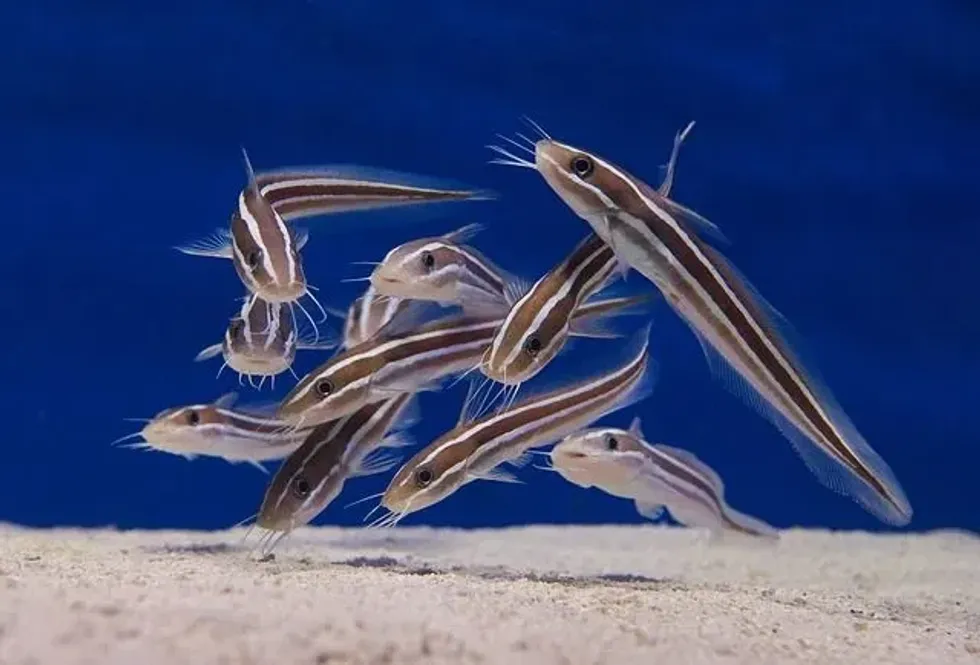The blue catfish is a resident of a freshwater river. They can be easily found in the Mississippi River. Apart from being a native species to the Mississippi River, these invasive fishes are also seen in places like Virginia, Maryland, Chesapeake Bay, and more.
This species is common in southern American states like Texas. Mexico is another country in the south where they are common. These invasive and native species from rivers of Maryland, Virginia, and other parts of the world, have whiskers which are called barbels.
They also have a forked tail. These species are known to eat blue crabs and small fish among other things.
However, they are not considered violent predators. Although, they might look the part with their large barbels. Speaking of their appearance, they can be distinguished from other species of catfish like the flathead catfish, and the channel catfish through their looks.
In this article, you will get to read about the giant blue catfish, blue catfish diet, blue catfish lifespan, their eggs, piebald blue catfish, blue whale catfish, wild blue catfish, blue cory catfish, the scientific name for blue catfish, blue catfish vs channel catfish facts, and much more. Happy learning!
If you like this article, check out cobia and cory catfish.
Blue Catfish Interesting Facts
What type of animal is a blue catfish?
The blue catfish is a type of fish.
What class of animal does a blue catfish belong to?
The blue catfish belongs to the class Actinopterygii.
How many blue catfish are there in the world?
The exact population of a blue catfish is not known. However, there has been a stocking-up of blue catfish in 20 American states so that they can be fished. In today's world, the number of blue catfish is so vast that it is having a negative impact on the ecosystem, especially the environment of bays.
Where does a blue catfish live?
A blue catfish lives in freshwater rivers. They are native to the rivers flowing through Mississippi, Ohio, Missouri, Virginia, and Maryland.
They also reside in the Chesapeake Bay where they can be found in huge numbers. Their population in the Chesapeake Bay is so inflated that they pose a problem. They are also found in the York River, James River, and the Rappahannock River.
What is a blue catfish habitat?
The blue catfish resides in the depths of rapidly flowing rivers. They can also be found in channels. Their high adaptiveness for varied salinity levels, water conditions, and habitats makes them suitable for varied living conditions as well.
As a rule of thumb, they seek currents with cool water in summers and warm currents in the colder seasons. During the daytime, their movements are restricted to the river -bed. On the other hand, their nocturnal nature helps them to swim to the surface for food during the night.
Who do blue catfish live with?
The adult catfish is by large a solitary creature. They like to be by themselves. This is in contrast to their larval stage, where they are produced in huge groups which stay together.
How long does a blue catfish live?
The average lifespan of the blue catfish is almost a decade, although certain blue catfish have been known to live to be 25 years old.
How do they reproduce?
The reproduction process of a blue catfish takes place once annually between the months of April and June. This mating process usually occurs in water bodies with a lower salt content than where the blue catfish usually lives.
The venue is also generally a smaller tributary. Their annual reproduction process is monogamous in nature.
The male blue catfish nest in dark and sheltered areas. They clean the nesting area by doing away with debris or larger items with their tails and jaws respectively.
After building a nest of about 3-7 in (8-18 cm) radius, the male blue catfish attracts the female blue catfish by releasing pheromones. The couple then displays their courtship through patterns while swimming.
After courting, reproduction occurs and the females reproduce 2000-4000 eggs. Unfortunately, it may be seen that after fertilization of the eggs the females are ousted from the nest by the males in an attempt to shelter the eggs.
The baby blue catfish, after they hatch, form close-knit schools. The blue catfish follow a patriarchal structure when it comes to caring for their young ones.
What is their conservation status?
The population of the blue catfish is quite stable. Hence, they are listed by the International Union for Conservation of Nature (IUCN) as animals of Least Concern.
Blue Catfish Fun Facts
What do blue catfish look like?

The blue catfish is bluish-gray in color. Meanwhile, the abdomen of this fish or the underpart is white.
Their heads are large, and they flaunt a deeply forked tail. They have smooth and slimy skin which is devoid of scales. The name 'humpback blue' originates from a dorsal fin or bump in the middle of the back of blue catfish.
How cute are they?
The blue catfish is not at all cute. They look quite gruesome. They have a large flat head and long ugly whiskers. Their large mouth does not help in the appearance either.
Their scale-less skins are very slimy too. Hence, no aspect of their appearance adds up to the blue catfish being cute. They have a sharp edge that adorns their anal fin.
How do they communicate?
The blue catfish communicates by releasing pheromones into the water they reside in. Their sensory organs also play a role in the communication process. Unlike most other species, the blue catfish has a higher communication process which includes a pecking order.
The whiskers of the blue catfish are capable of taste and are instrumental in sensing their environment. They also have taste buds at certain spots on the surface of their bodies.
These excellent senses of taste help them to hunt down food. The blue catfish has relatively poor eyesight. This, they have to rely on their senses of smell and taste to get by.
How big is a blue catfish?
A blue catfish ranges from 24 to 60 in (64 to 152 cm) in length. They are more than double the size of a wild goldfish.
How fast can a blue catfish swim?
The blue catfish is not a very agile species. They have a swimming speed of 0.6 mph (1 kph).
How much does a blue catfish weigh?
The blue catfish weighs approximately 88-110 lb (40-50 kg).
What are their male and female names of the species?
The male and female blue catfish have not yet been assigned any particular terms based on their genders. They are simply called male blue catfish and female blue catfish.
What would you call a baby blue catfish?
A baby blue catfish is called a fry.
What do they eat?
The blue catfish (Ictalurus furcatus) is an invasive species that feed on the bottom of the water bed. They eat a number of things ranging from worms, small crustaceans, clams, mussels, and small fish, to crabs and frogs. They can also show traits of cannibalism by eating other blue catfish.
They have a seasonal appetite. This means that except winter, they rely on plant matter for their diet. Young blue catfish feed on small insects.
Are they eaten by humans?
Yes, humans do eat blue catfish. A blue catfish is considered a tasty food. Their abundant availability has led to the blue catfish being sold to grocery shops, restaurants, as well as seafood stalls.
Would they make a good pet?
Yes, a blue catfish can make for a good pet. They are dwellers of fresh water, so the water in the aquarium should be set up keeping that in mind. They are known to mix well with other aquatic animals and are generally not much of a hassle.
Did you know...
The blue catfish has a growth rate that varies according to the habitat and climate they live in, as well as their diet. Once they reach a length of 7 inches, they consequently put on weight rapidly.
They have mild venom within their backbones. Although, the amount of poison is so negligible that this venom is not generally harmful, thus making them non-dangerous.
These spines are present on the dorsal and pectoral fins. If you are into angling, which is a style of angled fishing, then you should beware of hazards that may arise while fishing since their spines might break.
In order to catch blue catfish, you have to use bait when fishing for them. The best option for bait is a skipjack or a shad.
Skipjack is a tiny tuna, and a shad is a type of fish that is used in sports. These are live baits that give you a better chance at catching a blue catfish than artificial or dead baits.
There are various recipes to cook the blue catfish. Make sure that the fish is thoroughly cleaned before cooking though. However, you should eat it in moderation since the animal contains a little quantity of mercury which can pose nerve-related issues for humans if consumed in large amounts or on a daily basis.
There is some distinct difference in the appearances of a blue catfish and a channel catfish for you to tell one from the other. Firstly, they differ in coloration.
While the former is bluish-gray in color, the channel catfish has a slate-gray or olive coloration.
In the case of the blue channel fish, the upper jaw is more protruding while it is the reverse for blue catfishes. Additionally, the anal fin is adorned with 24-29 rays in the case of a channel catfish, while the number of the same is over 30 for the blue catfish.
It is a myth that these invasive species are stingers. Though they have long whiskers or barbels, they do not have the capability to sting using the same.
The baby blue catfish is often at risk of being preyed on. In order to save themselves from such worrying causes, they set out to hunt at night. Their diet consists mainly of planktons in the form of zooplankton and other small insects which are native to the water bodies where this invasive species lives.
What is the biggest blue catfish ever caught?
In 2011 in Kerr Lake, Virginia Richard Nicholas Anderson caught the biggest blue catfish, thus setting a world record. Blue catfish weigh around (88-110 lb (40-50 kg) but this world record blue catfish weighed 143 lb(64.86 kg) and measured 4.75 ft (1.45 m) in length.
Where do blue catfish lay their eggs?
Blue catfishes are cavity nesters. This means that their eggs can be found in crevices.
Here at Kidadl, we have carefully created lots of interesting family-friendly animal facts for everyone to discover! Learn more about some other fish including neon tetra and channel catfish.
You can even occupy yourself at home by drawing one of our Blue catfish coloring pages.









